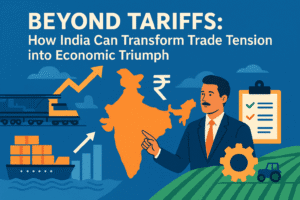Beyond Tariffs: How India Can Transform Trade Tension into Economic Triumph
Facing potentially devastating US tariffs risking $30-$35 billion in exports and 1% GDP growth, India must transform this crisis into opportunity. Success hinges on aggressively diversifying exports towards Africa and West Asia for pharmaceuticals, renewables, and agriculture, while slashing crippling logistics costs (8-9% of GDP) through urgent infrastructure upgrades. Bold domestic reforms are non-negotiable: modernize land acquisition, streamline labor laws, revolutionize agriculture with inter-state trade and processing zones, and simplify GST/income taxes.
Simultaneously, turbocharge forex inflows by becoming a top-tier tourism destination, attracting foreign capital via policy stability and divestment, leveraging record diaspora remittances, and expanding high-value Global Capability Centers. Decisive execution across these fronts can reposition India’s economy, turning external pressure into sustainable strength and global competitiveness.

Beyond Tariffs: How India Can Transform Trade Tension into Economic Triumph
The US decision to impose steep tariffs—potentially reaching 50%—on key Indian exports like textiles, gems, jewellery, and agriculture isn’t just a trade hurdle; it’s an economic earthquake. Projections suggest $30-$35 billion in export losses, shaving nearly 1% off GDP growth and rattling investor confidence. Yet, history and India’s inherent strengths suggest this crisis holds the seeds of profound opportunity. The path forward demands bold, coordinated action across multiple fronts.
The Stakes Are High: These tariffs target the heart of India’s US trade, potentially impacting 55% of its $87.3 billion merchandise exports and eroding a crucial $45.8 billion surplus. Labour-intensive sectors face acute pain, threatening jobs and growth. Foreign investors are already showing nerves, pulling billions from equities. Inaction risks a vicious cycle of declining exports, slowing growth, and capital flight.
Turning Adversity into Advantage: A Strategic Blueprint
- Rewrite the Export Map: Over-reliance on the US market is unsustainable. The answer lies in aggressive geographical diversification. Africa and West Asia offer immense potential for Indian pharmaceuticals, affordable automobiles, renewable energy solutions (especially solar PV), and advanced agricultural tech. Strategic government support for exporters, coupled with focused trade diplomacy, can open vital new growth corridors and build resilience against future protectionism.
- Unlock Manufacturing with Logistics Revolution: India’s Achilles’ heel remains logistics costs (8-9% of GDP). A massive infrastructure overhaul—prioritizing multi-modal parks, modernizing ports/inland waterways, and deploying integrated digital freight platforms—is non-negotiable. Every rupee invested here yields ₹2.5-₹3.5 in GDP. Slashing these costs is fundamental to boosting manufacturing competitiveness globally.
- Harness the Tourism Powerhouse: Tourism is an under-leveraged forex engine. Transforming India into a top-tier destination requires immediate upgrades: world-class airport and road connectivity in key circuits, simplified visa processes (expanded e-visas, faster approvals), compelling global marketing, curated cultural/adventure experiences, and PPP-driven resort/heritage development. Longer stays and higher spending directly counter export losses.
- Magnetize Foreign Capital (FPI): Restoring FPI confidence needs more than stability. It demands regulatory clarity, policy consistency, seamless digital onboarding, a deeper settlement cycle, harmonized tax treatment, higher investment limits, and innovative instruments. Strengthening corporate governance and minority protections are equally crucial for sustained inflows.
- Cultivate Agricultural Competitiveness: Agriculture reform is overdue and critical. A central law guaranteeing unfettered inter-state trade is essential. Incentives for diversifying into pulses, oilseeds, and high-value crops boost farmer incomes. Modernizing APMCs with cleaning/grading/cold-storage facilities reduces waste, while developing agro-processing zones and rural-market links integrates farmers into global value chains.
- Forge the Manufacturing Foundation (Land, Labour & Mining):
- Land: Streamline acquisition, secure titles, consolidate plots, create land banks, and establish fast-track dispute resolution. Flexibility and transparency are key to attracting global manufacturers.
- Labour: Consolidate complex laws into a single, modern code enabling flexible hiring, simple registration, and quick dispute resolution. Aligning with global standards integrates India into supply chains.
- Mining: Revive this critical sector (11% of industrial GDP) by easing exploration norms (via MMDR Amendment), launching an “Explore in India” mission, promoting tech (drones, AI, GIS), and developing mining corridors. Unlocking critical minerals is strategic.
- Simplify the Tax Web: The landmark Income Tax Bill 2025 replacing the 1961 Act is a start. Complementing this with GST simplification (fewer slabs, inclusion of petroleum) reduces compliance burdens, eliminates tax cascading, and enhances India’s business appeal and competitiveness.
- Strategic Divestment for Capital & Efficiency: Privatizing or partially divesting premium state-owned assets serves dual purposes: attracting significant global capital (forex) and driving operational efficiency in these enterprises.
- Leverage the Diaspora Dividend: Record $136 billion remittances (FY25) are a powerful buffer, covering nearly 47% of the merchandise trade deficit. Proactive engagement with the diaspora can further strengthen this vital, resilient source of forex, offsetting tariff impacts and stabilizing the rupee.
- Supercharge Global Capability Centres (GCCs/BPOs): India’s 1,700+ GCCs (growing to 2,200 by 2030) are evolving from back offices into global hubs for innovation, AI, and R&D. Targeted state policies promoting Tier-2 cities and expansion into new verticals (portfolio management, financial analytics) can propel this $100 billion+ revenue engine, attracting strategic foreign investment and forex.
The Imperative: Boldness & Pragmatism
The US tariffs are a stark warning against over-dependence and a catalyst for long-overdue transformation. Success hinges on simultaneous execution across these diverse fronts – unlocking stalled reforms, strengthening domestic demand, and modernizing policymaking. This isn’t just about weathering a storm; it’s about fundamentally repositioning India’s economy. By converting this external pressure into internal momentum, India can emerge not just resilient, but stronger, more diversified, and firmly entrenched as a leading global economic power. The opportunity is immense; the time for decisive action is now.
You must be logged in to post a comment.